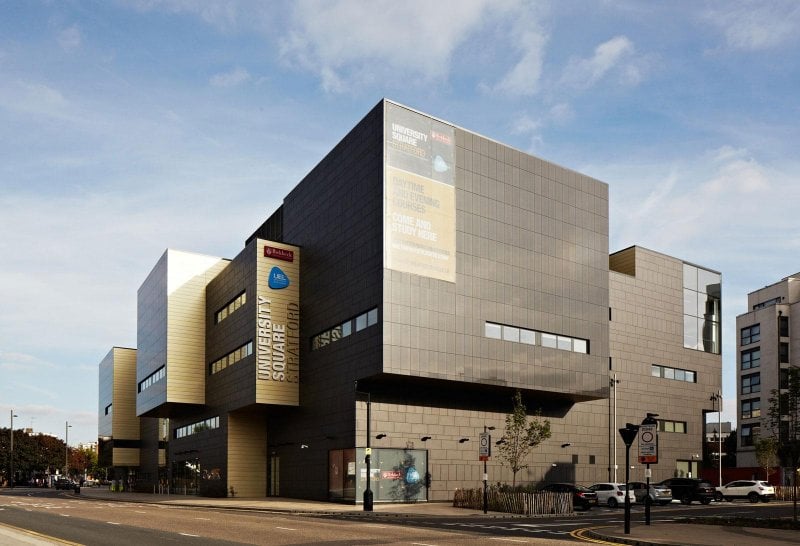
University Square, Stratford
How the other Stratford lives
Liz Pearson is certain that partnerships between educational and public cultural bodies are maintaining the momentum behind Stratford’s cultural regeneration.
Stratford has arguably been one of the most high-profile regeneration stories of recent years. For the 2012 Olympic and Paralympic Games, over two square kilometres of disused warehouses and railway yards, scrap car and trolley-filled rivers were transformed into the Queen Elizabeth Olympic Park. ‘Fridge mountain’, one of the largest piles of discarded white goods, has been replaced by one of the largest shopping centres in Europe, Westfield Stratford City. And visitors can now reach the area via the new transport network built to support the 2.5 million people who attended the Games.
The promise was that such large-scale investment would result in longer-term economic and social transformation – and Stratford certainly now looks and feels a very different place. But the cultural regeneration of an area is just as important and, as the London Borough of Newham still has one of the country’s lowest arts participation rates, there is a continuing job to be done in making the arts visible and accessible.
As anchor institutions in their communities, universities and arts and culture organisations have a shared interest in increasing participation
Leading the way in this respect is Stratford’s Cultural Quarter, to which the University of East London (UEL) has just added a new £33 million campus, University Square Stratford. This is home to our performing arts department, with its urban dance, music and applied theatre undergraduate degrees, and its MAs in acting and directing. Being neighbours with long-established cultural venues, such as Theatre Royal Stratford East, Stratford Circus and Stratford Picture House, is exciting and beneficial, and has added fresh impetus to the long-standing collaborative partnership between the four of us.
Co-location and collaboration is a heady mix. In a world where we are all challenged to sustain engagement and participation, the Stratford model of partnership and collaboration might offer interesting pointers for other areas of the UK. The notion that universities can and do play a significant part in driving the economic, social and cultural development of the area in which they are located is long established. They are highly visible institutions – bricks and mortar proof that opportunities remain open and accessible. Cultural institutions do much the same thing. They create relationships and opportunities, and bring vibrancy to their communities.
In Stratford, collaboration between UEL and our Cultural Quarter partners has helped us to devise and shape a distinctive educational offer, one that reflects the interests, experiences and aspirations of students from diverse communities in east London. Our curriculum draws on a broad range of local cultural traditions and seeks to support students as they develop their identities as professional practitioners and navigate the pathways into working life.
Collaboration with our Cultural Quarter neighbours plays an invaluable part in our work with students, and contributes to our shared goal of improving participation in the arts in Newham. Curriculum topics and neighbouring arts venue programming are frequently planned in tandem, and students often get the opportunity to work and perform in professional venues. An Arts Pass bursary scheme enables students to attend performances, workshops and screenings where they can see and experience professional artists and companies at work.
As anchor institutions in their communities, universities and arts and culture organisations have a shared interest in increasing participation. But at UEL our experience of establishing and sustaining partnerships for the long term has taught us that all parties need to work on the basis of openness and trust, and to recognise the very real constraints that shape our working lives. Different funders, for example, have different priorities, and organisations trying to work in partnership can all too often find themselves at the mercy of non-aligned rules and regulations. Cuts in funding also bring pressures and can easily undercut the capacity of organisations to work collaboratively. But one of the lessons we have learned is that the creative sharing of experience, expertise and resources is uniquely effective in sustaining organisational capability and delivering continued innovation.
Every area of the UK will have its own arts-education partnerships, but from our Stratford, East London perspective, the time we have invested in collaboration has paid dividends. Our curriculum and the experience we offer our students are enriched, and in turn our graduates play their part in shaping the continuing arts and cultural offer of the community.
A shared interest in developing the artists and audiences of the future should be at the heart of a successful arts-education partnership and will go a long way towards sustaining commitment even through challenging times.
In post-Olympics Stratford, the baton of regeneration has been passed on and cultural and educational organisations are rising to the challenge. Times are tough, but our history of collaboration and our shared commitment to supporting young people to develop into tomorrow’s arts and culture professionals is sustaining our capacity to work together. We are finding that with differing interests and points of view at the table, developments can take unexpected directions. We are beginning, tentatively, to explore whether there are better business models for supporting engagement in arts, culture and education, particularly given our shared interests in navigating a world with reduced public subsidy. Our partnership has developed into a meeting of minds and that is a huge asset. Sure, there are huge challenges facing us but in Stratford it does feel like a collaborative approach works – for students, communities, and arts and education professionals.
Liz Pearson is Associate Dean of the School of Arts and Digital Industries at the University of East London.
www.uel.ac.uk
Join the Discussion
You must be logged in to post a comment.